 |
| TRAVEL LIFTS (Pages 2 to 3) |
| |
|
| |
|
| Main framework |
| |
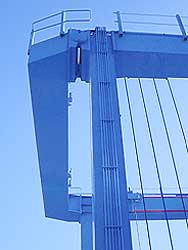 Box-section components for heavy loads, heat laminated and hermetically assembled to avoid internal corrosion, all in compliance with international standards. Box-section components for heavy loads, heat laminated and hermetically assembled to avoid internal corrosion, all in compliance with international standards.
One front-mounted crossbeam with pivot joints that is designed to eliminate stress in the main framework when moving over uneven ground.
Allows increased movement of the prow stays.
The structure of the framework is screwed together with highly resistant zinc-coated screws.
The structure of the framework completely complies with FEM, (DIN) ISO and BS standards, as well as every other international standard. |
| |
| |
|
| Movement mechanism |
| |
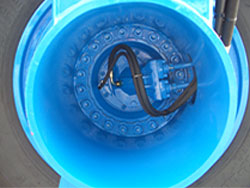
The system comprises 4 hydraulic motors that are directly attached to the driving wheels, thus eliminating the maintenance costs associated with chain transmissions and ensuring safety in the event of failure.
The transmission gearboxes are 3-stage epicyclic ones and are mounted on the wheel drum with a hydraulic brake. They are driven by the powerful multi-piston engine that provides excellent starting for incline work.
The transmission circuit incorporates a hydraulic valve to control and stop excess speed. It automatically stops the elevating winch in the event of high downward speed. It also applies the transmission brakes in the event of driving power or flexible tube failure.
The security brakes can also by applied in case of multi-disc failure of each driving wheel due to oil. |
| |
|
| |
| |
|
| Turning mechanism |
| |
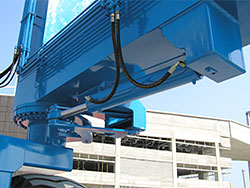 There are two ways of turning, depending on the number of steering wheels on the travel lift. There are two ways of turning, depending on the number of steering wheels on the travel lift.
The system with two-wheel steering has a larger radius on exterior turns, but its manoeuvrability when it comes to going into water or launch harbours is easier and simple, since the interior turning radius on 4-wheel models is zero and very low on 8-wheel models. This minimum turning radius is possible due to the 90o Ackerman steering system.
On the other hand, the system with 4-wheel steering allows manoeuvrability in smaller areas that require tight turns since their exterior turning radius is less than that of the previous system. Ackerman 4-wheel steering is also available for certain applications.
Each steering drum includes rapid alignment valves, and centring indicators are placed on each turning ring. Each drum contains 2 screws for bleeding air.
Nickel and chrome-plated turning pivots and piston rods are used to prevent corrosion.
|
| |
|
| |
| Turning mechanism – multi-modal steering system (optional) |
| |
One of the latest turning options for travel lifts is the Multi-Modal Steering System. Its main characteristic is that all its wheels steer, but it also has the advantage of allowing the operator to select various sorts of manoeuvre on the control panel, such as:
- Independent front and rear steering. This allows turning with 2-wheel steering, but provides a choice between the front 2 wheels or the rear 2.
- ‘Roundabout turn’: The wheels’ axes are aligned with the travel lift’s geometric centre, thus allowing it to turn in the smallest possible area.
- Diagonal movement: All the wheels turn the same number of degrees, up to a maximum of 65o, thus allowing the travel lift to move diagonally. |
| |
|
Independent front and rear |
| |
|
‘Roundabout turn’ Diagonal movement |
| |
| |
|
| Wheels |
| |
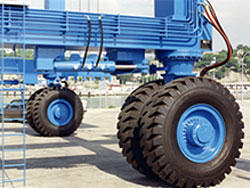
WISE machines up to 150MT have four wheels, and the use of 8 wheels is reserved for greater capacity machines.
The use of 4 wheels allows for more compact machines to be made in terms of their useful interior width.
The new machine wheels used in machine lifts are available in standard sizes, which is advisable due to their service and life-span.
The wheel arms are made from box steel with internal reinforcement to support the wheels’ gearboxes and axis bearings. They include suitable points so they can be jacked up to change wheels, as well as horizontal alignment screws so the axis bearing to the wheels can be positioned correctly.
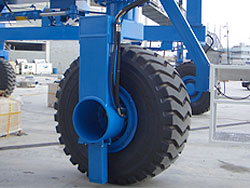 The projecting cradle system has produced satisfactory results, particularly in terms of the ease of wheel changes and the greater available space. The projecting cradle system has produced satisfactory results, particularly in terms of the ease of wheel changes and the greater available space.
On the other hand, the travel lifts are fitted with safety arms to prevent accidents in the case of tyre failure.
|
| |
| |
| |
|

